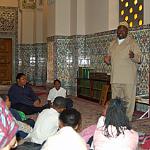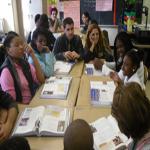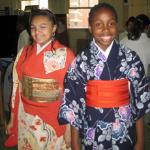February 04, 2011

Photo: District of Columbia Public Schools
Students from Deal Middle School in Washington, D.C., perform at the Indonesian Embassy.
Embassy representatives in Washington, D.C., work regularly with lawmakers on Capitol Hill and U.S. officials at the State Department.
Nearly four dozen of them also extend their diplomatic efforts into city schools. They visit hundreds of 5th and 6th graders in D.C. classrooms, as part of the Embassy Adoption Program.
Getting to know you
In one classroom at Aiton Elementary School, the Embassy of Saudi Arabia is hosting a fashion show. Staffer Tarik Allagany explains the different types of robes and head scarves as students model traditional Saudi dress.

District of Columbia Public Schools
Students from Martin Luther King Elementary School visit the Islamic Center in Washington, D.C. with staffers from the Saudi Embassy.
"They put patterns on them," he says. "Anything that they see in the desert - colors, flowers."
The 5th grade class is part of the Embassy Adoption Program, which matches embassies with classrooms in the nation's capital. Each year, the program gives thousands of youngsters a unique, inside look at another country and its culture.
After their fashion show, the Aiton students munch on sweet dates, and ask Allagany about other aspects of Saudi life.
"Who's the first Muslim in the world?" asks one student.
"That would be Prophet Mohammed," Allagany answers.
Allagany wants students to know about the relationship between the United States and Saudi Arabia which, he says, is not just about oil.
"We have the cultural ties, the educational ties, the healthcare ties, even the social ties and I haven't even touched on the political alliances between our two countries."

District of Columbia Public Schools
Representatives from the Israeli Embassy in the classroom at Hendley Elementary School.
Cultural outreach
Riyadh's embassy is one of 45 that participate in the Embassy Adoption Program.
Kate McNamee, coordinator of the 37-year-old program for D.C. Public Schools, says the interactions have been as varied as the countries themselves.
Students in one class made French food. Staff from the Mexican embassy helped their adopted classroom make pi?atas - the brightly colored papier-maché decorations usually filled with candy treats. One class video-conferenced with students in Luxemburg. Another began judo lessons after the embassy of Japan donated mats and uniforms.
"It's not just another add-on, and another thing to take away from the school day," says McNamee. "It becomes a creative, dynamic way to teach curriculum."
One class learned about exchange rates using Canadian currency in math, and another - in science class - discussed how climate change is affecting Finland.
These interactions sometimes gloss over serious concerns, such as disputed political boundaries or women's rights in other countries. McNamee says school officials are working on a revised curriculum with the State Department so children will also learn about the U.S. government's relationship with each country, and gain a more balanced view of the world.
What connects us
Njambi Wynn ran the Embassy adoption program for two decades, and still helps with its activities. She says in addition to facts about their adopted country, students learn respect for other cultures. That respect sometimes includes sampling unfamiliar foods.

District of Columbia Public Schools
Students in traditional Japanese clothing
"We say just take a little bit. You don't go, 'Oooh, I don't like that!' You try it, you say 'Thank you very much' and you're appreciative of anything anyone does for you," says Wynn.
Even as children learn about differences, they also learn about what connects us all.
Ten-year-olds at Eaton Elementary, who were adopted by the Embassy of South Africa, listen to a firsthand account of life there from Ambassador Ebrahim Rasool.
"How did it feel during apartheid?" asks a student.
"I remember when I went to high school, within the first three months, I was involved in my first march against apartheid because the school was so bad," says Rasool. "It was raining and cold outside but we had no ceilings, we had no heating. Every five children shared one textbook."
At the end of the year, children visit their adopted country's embassy to present what they've learned.
Njambi Wynn still remembers the year some students performed a rap song about King Henry and his wives at the British embassy, to the amusement of the ambassador. Another class performed a traditional Indonesian dance, while another began by singing the Cyprus national anthem.
"And they did it in Greek. The ambassador, his wife, his staff, they all had tears in their eyes," says Wynn. "They were so pleased. This year, they have Japan and the teacher says 'We'll do it in Japanese, as well.'"
And why not? In an international city like Washington, one is never too young for global experiences.